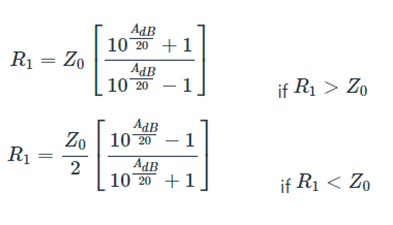Overview
The reflection attenuator calculator allows you to determine the two possible resistor values (R1 > Z0 & R1 < Z0) for a reflection attenuator (measured in Ohms). A reflection attenuators use two equal resistors, each grounded and connected to the same node, to attenuate a signal. For this reason, there are two possible solutions to the value of the resistors used, one larger than the system impedance and one smaller.

Formulas
there are two formulas for R1: one where R1 is greater than the characteristic impedance of the line to be match and another where R1 is lesser than that characteristic impedance.

Applications
Attenuators are passive circuits that are used to weaken the signal from a source to a level suitable for the destination. The source can be a transmitter circuit or a transmission line and the destination may be another transmission line or an antenna. Attenuators in RF applications are usually just a simple network of resistors.
Reflection attenuators have two or more discrete states (digital) and are most often they are used as variable phase shifters. Depending on the type of coupler used, such an attenuator can provide an octave bandwidth. In fact, reflection attenuators can provide an invariant response with careful design.












